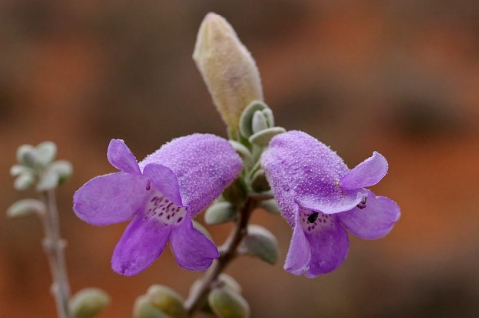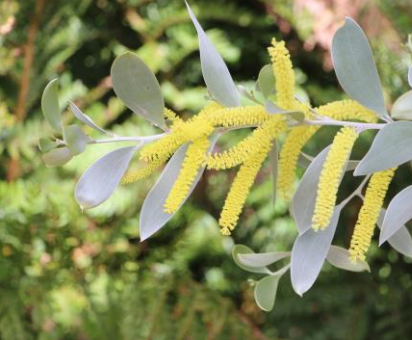Hakea SG newsletter no. 82, June 2023
Winter is flowering season for many Hakeas and there has been much for growers to admire. Several garden visits in Victoria displayed Hakeas growing in a range of soil types and climate variables (from 90 – 150 species per garden). The gardens provided members with a chance to see how adaptable Hakea species can be, and encourage them to try more species. In NSW, a dozen or so Hakea species survived the 2.6m of rain which drowned Phil Trickett and Catriona Bate’s garden at Milton. Replanting is underway including both grafted and seed-grown plants.
The newsletter provides a list of cold-tolerant species being trialled in a frosty garden at Armidale by Claire Mullins. Group leader Paul Kennedy reports on a number of species in the Hakea strumosa group. The species described are native to SA and WA.
Study Group contact is hakeaholic@gmail.com
Eremophila SG newsletter no. 140, September 2023

Eremophila decussata (pictured) is the feature species. It is found near Ooldea in SA and in a couple of other locations (SA and WA). It’s a low dense shrub best planted in open sites, and is mostly grown in drier areas. There are two established hybrids, one known as “Nullarbor Nymph”, plus other probable hybrids yet to be followed up. E. decussata is a great garden plant because it has (potentially) a long flowering period but is nevertheless neat and tidy when not in flower.
Steve Cathcart reports on his garden in Tumut which boasts 20-25 Eremophila species/hybrids. Frost is the main issue although some species survive despite being Lyndal Thorburn reports on the tally of Eremophila species recorded on a recent trip to Western Queensland. Location photos are included.
Study Group contact is lthorburn@viria.com.au
Fern SG newsletter no. 155, September 2023
A Fern Gathering has been held, including a number of excursions in coastal NSW locations. It ran from the 4th to the 7th November.
Sydney area members report on a beautiful walk in Neates Glen in July. Fern, moss and orchid finds are illustrated, plus some beautiful location shots. The SE Qld fern group had an excursion to Cunninghams Gap also in July, finding the forest floor lush with fern growth. 29 species were recorded. In August, the Blackall Range provided a perfect outing, with no less than 10 species at the Narrows Lookout alone.
Venturing further afield, Steve Lamont reports on a range of ferns observed on a short trip to New Zealand.
Study Group contact is ANPSAferns@bigpond.com
Hakea SG newsletter, No. 83, October 2023
Paul Kennedy has been busy propagating from seed. Hakeas from warm climates are an issue in his cold area, with seedlings having to overwinter in a hot house. Hakea pedunculata appears the hardiest of these, but Paul believes grafting is the way to go with northern species in cooler climates.
David and Linda Handscome are setting up a new 10-acre garden near Warrnambool, Vic. The climate is milder than their previous Pomonal location, but this is not altogether a good thing as rapid growth in the deep volcanic loan has meant stability problems and overcrowded garden beds. However more than 40 species of Hakea have been established successfully.
Study Group contact is hakeaholic@gmail.com
Australian Plants for Containers SG newsletter, No. 42, October 2023

Pimelea physodes, the Qualup Bell, is a magnificent plant which flowers reliably in a container in Canberra. Well-drained soil, protection from afternoon sun, and regular tip-pruning are key.
Xanthorrhea johnsonii hybrid x “Supergrass” has flowered twice in a pot in Mt Barker, S.A. It is a hybrid with amazing vigour. Hoya australis has been a success for Ian Cox of Parramatta Hills.
Group leaders Ros and Ben Walcott report on the specimens growing in pots at the Australian National Botanic Gardens in Canberra. In the same city, a range of plants in containers adorns their own patios, including Acacia binervia ‘Sterling Silver’ [pictured]
Study Group contact is roswalcott5@gmail.com and benwalcott5@gmail.com
Isopogon & Petrophile SG newsletter no. 33, November 2023
A notable point – Isopogons and Petrophiles do not produce nectar despite commercial plant labels claiming they are bird-attracting.
I.latifolius has the largest flower heads of all I & P species. Two compact forms which are currently available are “Dazzler” and “Lollypop”. In general, there has been a welcome increase in both the number and range of Isopogons & Petrophiles in nurseries.
Member Darren Allen of Pokolbin discusses his experience propagating from cuttings and grafting using material available from the group. He finds it better to root his rootstock cuttings before grafting. An open soil mix has proved better than cocopeat plugs, and grafts succeed better out of his misting system. However cooling the propagation area with a fog setup and added shade has been beneficial.
Phil Trickett finds Isopogon “Coaldale Cracker” easy to strike, and describes his method in detail. For his grafting, he has had to move on to using Parafilm. As it is less strong than Nescofilm he cuts wider pieces than formerly – approx. 5cm -2.5cm which is then doubled over, and wound tightly around the graft.
While it was predicted that the recent wildflower season in WA would be a flop, this was not the case for all areas. Visits to WA yielded many I & P observations, and these are documented by photographs.
Study Group contact is isopetstudygroup@gmail.com
Grevillea SG newsletter no. 126, November 2023
Subgroups have met throughout the year, and grafting has been among the topics for discussion. Recorded in the newsletter are comments from members regarding grafting methods, choice of stock and scion material, and methods of fertilization. John Elton is collecting information for a new grafting database.
Peter Olde describes Grevillea pieroniae and a new species G. aff. acropogon which he observed on a recent trip to Western Australia. Peter also introduces some new Kings Park hybrids which are being released into the horticultural industry.
Stephen Hodge is trying to track down extant specimens of the “Poorinda” range of hybrid grevilleas developed by his grandfather Leo Hodge. “Poorinda Diadem” is one he is keenly seeking.
Malcolm Johnson of Boongala Gardens is looking for Grevillea “Jessie Cadwell”, a release from the 1980s.
Study Group contact is bruce.moffatt@tpg.com.au
Acacia SG newsletter, No. 155, November 2023
A new species, Acacia armigera, has recently been named. It occurs near Southern Cross in Western Australia and is a low, dense, rounded shrub with spiny phyllodes.
Red Rock Wattle in Victoria is a commercial plantation producing native food products including wattleseeds. Starting in 2020, 9 acacia species were planted as a trial, and an extensive harvest is expected this year.
Several new books have recently been published about acacias, or including them. “Wattles : Australian Acacia species around the world” ed. Richardson may be of interest. It explores the biology, ecology and evolution of these remarkable Australian plants.
Study Group contact is acaciastudygroup@gmail.com
